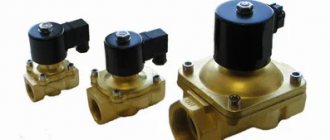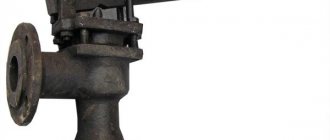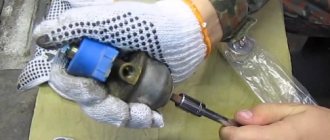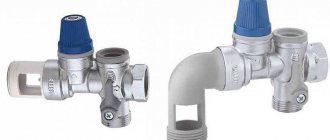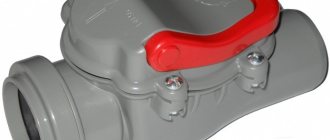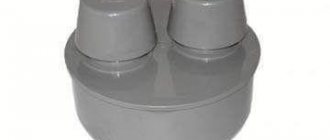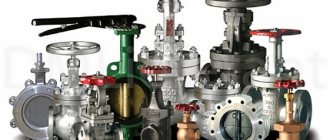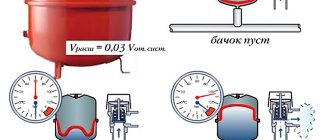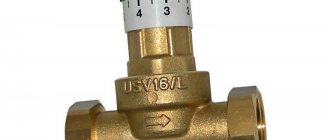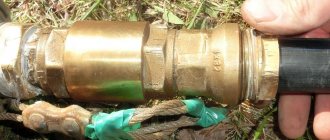When installing autonomous heating, it is necessary to take care of the safety and reliability of the system. In order for the heating system to be provided with automatic safety control, it is necessary to install a protective element called an electromagnetic shut-off valve. This protective element is a shut-off valve that ensures the safety and automatic operation of heating equipment.
If any dangerous situation occurs, the valve automatically shuts off the fuel supply. Such situations can occur due to various factors: a drop in coolant or gas pressure, a gas leak, or a decrease in draft. Any of these factors is dangerous for the operation of the boiler. Therefore, an electromagnetic shut-off valve is necessary for the heating system, as it shuts off the fuel supply. In our article we will consider the types of shut-off valves and the principle of their operation.
Purpose and design of solenoid shut-off valves
Regardless of their purpose, electromagnetic shut-off valves differ from other types of protective valves. Since it is triggered by external energy sources. The solenoid shut-off valve can be for water or gas.
The valve is activated using sensors that issue a command. Opening and closing can be done remotely. Such valves are often used in everyday life, in the energy sector, as well as in the food and medical industries.
The solenoid shut-off valve is used:
But the solenoid valve is more in demand in the energy sector. It controls the flow of fuel.
The valve may have one or more springs. They come in two types: disc and screw. In order for the springs to start working, it is necessary to use an electric or pneumatic drive.
The solenoid shut-off valve is a device that is equipped with an electric drive. The device contains latches that are controlled using electromagnets. The latches keep the springs charged. When a signal is given, the latches automatically release the springs and, therefore, the mechanism closes.
Purpose of the product
An electromagnetic shut-off valve for gas or water is activated by external energy sources. This distinguishes it from other types of shut-off and protective valves. The gas appliance is activated by a team of sensors. In addition, the valve can be opened or closed remotely.
The scope of application of shut-off valves is quite wide - the medical and food industries, the energy industry, and domestic use.
Without a shut-off valve the following cannot operate normally:
- heating and water supply systems, a valve is necessary to emergency stop the flow;
- systems in which the fuel supply (water, gas or oil products) is controlled automatically;
- air supply systems;
- irrigation systems in agriculture.
Electromagnetic shut-off valve on a gas pipe
Most often, an electromagnetic shut-off valve is used to regulate fuel flows in the energy industry, in installations with a large set of working environment parameters.
Valve device
A gas shut-off valve is an electromechanical device controlled by an electric current, which, passing through a magnet, creates an electromagnetic field. By its action, the field can both close the valve and open it.
The water shut-off valve has one or more springs in its design. The operating mechanism is a pneumatic or electric drive.
An electric drive is built into the electromagnetic valve for fuel cut-off. The device has special latches controlled by electromagnets. These latches lower the springs when a signal is given, thus closing the supply of the working fluid.
Types of electromagnetic shut-off valves. Principle of operation.
There are direct acting valves. In this form, the mechanism closes under the action of an electromagnetic drive. And the medium is cut off from both sides of the pipeline. There are also valves of the normally closed type. In this type, the valve operates under the influence of electromagnetic forces. If they are missing, the valve closes. A normally open type valve is open without any influence of electrical voltage. And closing is carried out using an electromagnetic pulse.
There are also solenoid pilot shut-off valves. They close under the action of the pilot. This mechanism works due to the pressure difference that occurs before and after. Once the required value is reached, the mechanism is activated and thus the valve closes. These valves are used in gas heating. They are normally closed and normally open. They can operate from an electromagnetic pulse.
There is another type of solenoid valve. Two normally closed valves of different nominal diameters are combined into one, which is called a two-port solenoid valve. Such valves can control fuel flow and are used for viscous liquids.
And solenoid valves with a rotary damper are used to shut off liquid fuel at a remote level. Such valves were manufactured to prevent the leakage of hydrocarbon gases. Solenoid valves with a rotary damper operate on the pressure difference between the outlet and inlet pipes. Such valves are installed on containers where gas is stored.
Using solenoid valves, you can remotely control the operation of the heating device. And also create automatic safe use. When using such a protective element, you can leave heating equipment unattended, as well as control it remotely.
Purpose of shut-off valve
The valve is an automated mechanism with a gate valve connected to an electromagnetic or pneumatic actuator. When the actuator is activated, the internal valve completely blocks the passage opening of the valve, stopping the movement of the working medium. The main part of the shut-off valve is a spring, which releases potential kinetic energy when the electric drive is activated and moves the device to the operating position.
This is interesting to know! An example of a mechanical shut-off device, which can be considered an older analogue of a shut-off valve, is a cast iron valve, which also blocks the flow of the working medium, but without the participation of automation using a flywheel.
As the name suggests, the valve completely “cuts off” the section of the pipeline where an emergency situation occurred, preventing water or other liquid from moving further. In practice this is necessary for:
- preventing a large leak of water, gas or other important resource;
- protection from chemical contamination of the territory;
- preventing damage to economically significant equipment, machinery, property;
- protection from damage to the life and health of enterprise personnel and civilians.
Most often, a shut-off valve can be seen in hot and cold water supply systems, gas supply, energy and petrochemical industries, and at various technological enterprises. In the domestic sphere, shut-off valves are installed on heating and plumbing equipment - heating boilers, in the area where filters, pumps, and heat exchangers are connected.
We recommend that you read: How to choose a needle valve for a pipeline?
Advantages and disadvantages
The advantages of valves include:
- Automatic signal in case of emergency.
- Heating equipment can be controlled remotely.
But in addition to the advantages, solenoid shut-off valves have the following disadvantages:
- You cannot install the valve on the gas pipeline yourself. To do this, you must use the services of a qualified technician.
- In order for the device to operate without interruption, it is necessary to install an additional power source.
Types of shut-off devices
The classification of locking devices is based on several key parameters. Based on their operating principle they are divided into:
- Normally open - in the normal state, the devices are in the open position, freely passing the current of the working medium. When the actuator is activated, the valve closes, stopping the flow of water or gas.
- Normally closed - before an emergency occurs, the valve is in a closed state, and when the actuator is activated, it opens and releases liquid or gas. Some types of devices require manual opening of the valve.
Based on the type of system and operating medium, shut-off valves can be classified into devices for water and gas. Valves for shutting off gas are divided into single-seat and double-seat. The first type of shut-off valve closes the system on only one side of the pipeline when gas extraction stops. Double-seat valves block the gas flow on both sides of the gas pipeline when the pressure in the system rises/falls.
We recommend that you read: Technological features of welding galvanized pipes
Shut-off valves for liquid working media are divided into four types:
- checkpoints;
- corner;
- single saddle;
- two-saddle.
According to the method of closing, valves are also divided into four categories:
- devices that close the flow of the working medium using a load;
- devices with a spring mechanism;
- devices with pneumatic drive;
- valves with electromagnetic drive.
Important! Modern shut-off valves operate on average 10-15 seconds after an emergency occurs. But when choosing a device, you need to pay attention to the response speed, because... You can mistakenly buy an old type device, which works much slower and is less airtight.
Installation of the device
Before installing the valve, it is necessary to select a place where free access to the device will be provided. This requirement must be adhered to in order to freely use the solenoid valve. The inlet and outlet parts of the pipeline must be located at the same level. And also these parts must support the weight of the device. Install the equipment taking into account the arrow pattern on the housing. The arrow must correspond to the direction of water movement. It is necessary to clean the pipes inside. Then, after installing the valve, you need to check the external and internal leaks.
Electromagnetic shut-off valves for heating boilers and their types
The autonomous heating system must be reliable, safe and “independent”. To ensure automatic control of safe operation, it is necessary to install a protective element - an electromagnetic shut-off valve.
An electromagnetic shut-off valve is a shut-off valve involved in ensuring the safe and automatic operation of heating equipment. The purpose of the valve is to shut off the fuel supply when a dangerous situation occurs.
An emergency situation in the operation of an autonomous heating system can occur from various factors: a drop in gas or coolant pressure, a decrease in draft intensity, a leak of flue or combustible gas. Each of these situations is dangerous and continued operation of the boiler is unacceptable, therefore the automatic protection system sends an electromagnetic signal to the shut-off valve. After this, the fuel supply to the boiler is stopped.
Types of solenoid valves
Electromagnetic shut-off valves can have various design features.
A direct acting solenoid valve is a mechanism that closes under the influence of an electromagnetic drive. The medium is cut off from both sides of the pipeline. They can be of the normally closed type - this means that the valve operates under the constant influence of electromagnetic forces; if they disappear, the valve closes.
A normally open valve is in the open state without electrical voltage. Closing occurs from an electromagnetic pulse.
Read about the operating principle and features of PB pellet burners in the article.
You can find out how to make an induction heating boiler by following the link -
Also read about solenoid shut-off valves.
The valves can be used in gas and liquid fuel heating systems.
Electromagnetic pilot shut-off valves are closed under the influence of an additional mechanism (pilot). It works due to the pressure difference before and after itself. When the set value is reached, the mechanism is activated and the valve closes.
The pilot valve can be operated by an electromagnetic pulse, like a direct acting valve. Such valves can be normally closed or normally open and are used in gas heating systems.
Double-port solenoid valves are two normally closed valves of different nominal diameters. They are used for viscous liquids and are capable of producing dosed fuel supply.
A butterfly valve solenoid valve is used to remotely shut off the liquid fuel supply.
Bottom high-speed solenoid valves are designed to protect against leakage of hydrocarbon gases. They are installed on gas storage tanks, and their operating principle is based on the pressure difference between the inlet and outlet pipes.
Electromagnetic valves make it possible to provide remote control of the operation of heating equipment, as well as automatic safe operation.
Main characteristics of shut-off valves:
- Type of transported medium and its consumption.
- Conditional pass.
- Medium pressure.
- Ambient temperature.
- Connection type.
Advantages of shut-off valves:
- Implementation of remote control of heating equipment.
- Implementation of automatic localization of emergency situations.
Disadvantages of shut-off valves:
- To ensure uninterrupted operation, it is necessary to install an additional power source.
- Installation of the valve on a gas pipeline is possible only with the participation of a qualified specialist.
Read about the causes of malfunctions of domestic heating boilers here.
On how to deal with scale in a boiler, you will find information at the link -
Also read about the prevention and repair of diesel burners.
Electromagnetic shut-off valves ensure safe and automatic operation of heating equipment. Their use makes it possible to leave heating boilers unattended and carry out remote control.
Modifications and executions
Based on their operating principle, MADAS gas valves are available in two types:
- Normally open two-position solenoid valves, which are open in a de-energized state and close when voltage is applied.
- Normally closed two-position solenoid valves that open when voltage is applied and close when there is no voltage.
According to the charging method, MADAS shut-off solenoid valves are manufactured with automatic or manual charging.
Depending on the method of connection to the gas main, MADAS shut-off valves are available with threaded and flanged connections.
| Gas shut-off valves, electromagnetic with automatic input, normally closed | |||
| Shut-off solenoid valve with automatic charging. Normally closed. Supply voltage 230V~ - 15% +10%. Valves with a diameter of DN32—DN50 have a built-in metal mesh of 100 microns. Valves with a diameter of DN65—DN100 have a filter element of 50 microns. Supply voltage 230V~ -15% +10%. | |||
| Threaded connection | |||
| EVGAC1M012 | DN15 | Pmax = 360 mbar | |
| EVGAC2M034 | DN20 | Pmax = 360 mbar | |
| EVGAC3M1 | DN25 | Pmax = 360 mbar | |
| EVGMC4M114SE | DN32 | Pmax = 1 bar | |
| EVGMC5M112SE | DN40 | Pmax = 1 bar | |
| EVGMC6M200SE | DN50 | Pmax = 1 bar | |
| Flange connection | |||
| EVGC0M065SE | DN65 | Pmax = 1 bar | |
| EVGMC0M080SE | DN80 | Pmax = 1 bar | |
| EVGMC0M100SE | DN100 | Pmax = 1 bar | |
| Gas shut-off valves, electromagnetic, with manual cocking | |||
| Shut-off solenoid valve for gas with manual cocking. Maximum pressure 500 mbar or 6 bar. Normally closed. Supply voltage 230V~ -15% +10% or -12V. | |||
| Threaded connection | |||
| EVGNC1L012 | DN15 | Pmax = 500 mbar or 6 bar | |
| EVGNC2L034 | DN20 | Pmax = 500 mbar or 6 bar | |
| EVGNC3L1 | DN25 | Pmax = 500 mbar or 6 bar | |
| EVGNC4L114 | DN32 | Pmax = 500 mbar or 6 bar | |
| EVGNC5L112 | DN40 | Pmax = 500 mbar or 6 bar | |
| EVGNC6L2 | DN50 | Pmax = 500 mbar or 6 bar | |
| Flange connection | |||
| EVGNC0LDN065 | DN65 | Pmax = 500 mbar or 6 bar | |
| EVGNC0LDN080 | DN80 | Pmax = 500 mbar or 6 bar | |
| EVGNC0LDN100 | DN100 | Pmax = 500 mbar or 6 bar | |
| EVGNC0LDN125 | DN125 | Pmax = 500 mbar or 6 bar | |
| EVGNC0LDN150 | DN150 | Pmax = 500 mbar or 6 bar | |
| EVGNC0LDN200 | DN200 | Pmax = 500 mbar or 6 bar | |
| Shut-off solenoid valve for gas with manual cocking. Maximum pressure 500 mbar or 6 bar. Normally open. Supply voltage 230V~ -15% +10% or -12V. | |||
| Threaded connection | |||
| EVGNA1L012 | DN15 | Pmax = 500 mbar or 6 bar | |
| EVGNA2L034 | DN20 | Pmax = 500 mbar or 6 bar | |
| EVGNA3L1 | DN25 | Pmax = 500 mbar or 6 bar | |
| EVGNA4L114 | DN32 | Pmax = 500 mbar or 6 bar | |
| EVGNA5L112 | DN40 | Pmax = 500 mbar or 6 bar | |
| EVGNA6L2 | DN50 | Pmax = 500 mbar or 6 bar | |
| Flange connection | |||
| EVGNA0LDN065 | DN65 | Pmax = 500 mbar or 6 bar | |
| EVGNA0LDN080 | DN80 | Pmax = 500 mbar or 6 bar | |
| EVGNA0LDN100 | DN100 | Pmax = 500 mbar or 6 bar | |
| EVGNA0LDN125 | DN125 | Pmax = 500 mbar or 6 bar | |
| EVGNA0LDN150 | DN150 | Pmax = 500 mbar or 6 bar | |
| EVGNA0LDN200 | DN200 | Pmax = 500 mbar or 6 bar | |
| Note. Counter flanges are available for an additional fee. | |||
